Weight Distributing Hitches for safe controlled trailer towing
I relate most of my towing experiences with going up and down hills. We have some tall hills in Colorado with snow still on them in the summer. Going down hill with a trailer pushing you and trying to steer you can get spooky. You will see semi-trucks adjust their weight with sliding 5th wheel hitches and sometimes sliding trailer axles. This is a good idea with your trailer also. Being able to adjust where the weight is distributed on your truck and trailer can give you the trailer capacity of a gooseneck or 5th wheel. If you are pulling a bumper type trailer (conventional, tag-a-long) having a Weight Distributing Hitch will improve your trailer sway, weight distribution and stress.
Horse trailers need it, boat trailers need it and there's a reason so many RV travel trailers have them. I see more and more enclosed car haulers in Colorado using WD hitches. Horse trailers seem to be the final frontier for WDH popularity. Hauling live tall animals, having a high center of gravity naturally, would the easiest place to see the dramatic improvement the WD hitches can add for better steering control and braking that, a level stable rig provides. WDH can do more to safely level your sagging vehicle rear end than all the springs, shocks and air bags combined. The WD hitch also places the trailer a few inches back to give you more room for a tight turn.
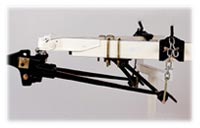 This WDH is a dual cam type that allows the spring bars to double as anti-sway devices. The outside bar will increase pressure on the hitch movement as the inside bar rolls over the cam indent in the spring bar. This is Reese's Dual Cam Sway Control. Last year Reese introduced a Dual CamHP for heavy duty applications. This WDH is a dual cam type that allows the spring bars to double as anti-sway devices. The outside bar will increase pressure on the hitch movement as the inside bar rolls over the cam indent in the spring bar. This is Reese's Dual Cam Sway Control. Last year Reese introduced a Dual CamHP for heavy duty applications. |
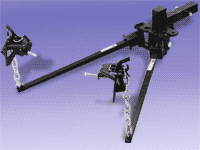 To explain what a WD hitch does, think of it as a bridge between the towing vehicle and your trailer. This bridge comes complete with an adjustable under truss called spring bar/arm or trunnion bars which join the trailer "V" tongue of the trailer to the hitch head and receiver hitch that arches the bridge upward to spread out the weight.. The head with the trailer ball attached to the trailer coupler/hitch, bolts to the shank which is "L" shaped with adjustment holes for proper hitch height. The shank slides in to your receiver hitch which is bolted to the towing vehicle's frame or sub-frame. This union allows you to distribute the trailer weight evenly to all axles of the truck/SUV and trailer. Thus the name "weight distributing" hitch. The picture here shows the shank, head, spring arms, chains and snap-up brackets with a typical WDH. To explain what a WD hitch does, think of it as a bridge between the towing vehicle and your trailer. This bridge comes complete with an adjustable under truss called spring bar/arm or trunnion bars which join the trailer "V" tongue of the trailer to the hitch head and receiver hitch that arches the bridge upward to spread out the weight.. The head with the trailer ball attached to the trailer coupler/hitch, bolts to the shank which is "L" shaped with adjustment holes for proper hitch height. The shank slides in to your receiver hitch which is bolted to the towing vehicle's frame or sub-frame. This union allows you to distribute the trailer weight evenly to all axles of the truck/SUV and trailer. Thus the name "weight distributing" hitch. The picture here shows the shank, head, spring arms, chains and snap-up brackets with a typical WDH.
|
On your receiver hitch or hitch receiver, you will usually see the tag with classifications for maximum tongue weight and maximum trailer weight. The lower weight is for WC which is "Weight Carrying" hitch or drawbar/stinger. In this situation all the tongue weight is on the WC hitch, draw bar. The other classification on the tag found on your towing vehicle's receiver hitch is the higher weight carrying capacity for WD which is the "Weight Distributing" hitch that spreads out the tongue weight of the trailer.
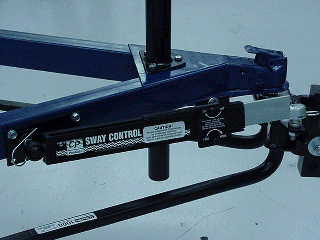
This WD hitch has a friction type anti-sway bar. But instructions may tell you to loosen sway bar during rain or snow on some brands. That's when I want anti-sway the most. And more bolts to drill into the trailer hitch. But this is the cheapest system of the three types of sway control.
- #1 Friction
- #2 Dual Cam
- #3 Spring bar
|
The first place I remember seeing the WD hitch is with folks pulling RV travel trailers. Which used to be the gray haired, retired, fixed income conservative types. (Always watch this group, they seem to know something.) These big square travel trailers catch a lot of side wind and do the Elvis hip action when semi trucks pass them. A good properly adjusted WDH can take the sway, pitch and dip away from your trailer trying to react to wind, semi suction, pot holes and my favorite "swerving to miss the Angus cow crossing the road at midnight." Your can't control the other drivers or debris in the road. So when you need to do those quick lane changes to avoid an accident, be sure your trailer will recover from that quick movement without taking you down the ditch and over.
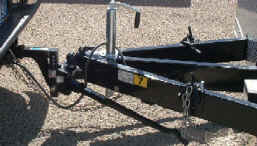
|
Typical WDH set up with adjusted shank height and spring bars tension adjusted by the links on the chain. Notice the trunnion bars or spring bars are hanging lower only using a few links. The truck pulling the trailer was a one ton dually and didn't need as much tension on the WDH.
|
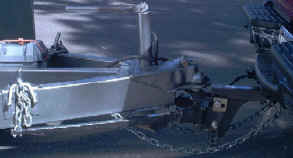
|
| This trailer is a heavy enclosed car trailer needing almost all the chain links possible for the proper tension on the spring bar to spread the weight out to all truck and trailer axles. |
Adjusting the WDH
Your WD hitch will come with instructions and to gain the full benefit from a WDH, you need to transfer the weight to all axles of the tow vehicle and trailer. Too much lift from a over tightened spring bars will cause a rear wheel vehicle to loose traction on say a slippery boat ramp or mud and snow. Ideally you want the tongue weight carrying 10 to 15% of the trailer weight. Weight Distributing hitches are rated to carry more tongue weight than a Weight Carrying hitch or drawbar.
In an interview with one of the Reese Hitch engineers at SEMA I was told that ideally when loaded the rear of your towing vehicle should only be one inch lower than the front measured inside the wheel well. And similar to a gooseneck/5th wheel setup, you'll end up with 1/3 of the trailer weight on the tow vehicle. I'd be inclined to shoot for 1/4 of the trailer weight on the towing vehicle. To be precise you may want to weigh your towing vehicle and trailer by axle to get your Gross Axle Weight Rating for the front and rear axles on both tow vehicle and trailer to see how well distributed the weight is.
In your tow vehicle if you look in the right side of the driver’s doorframe you'll see the Truck Safety Compliance Certification Label. On that label is your (GAWR) Gross Axle Weight Rating for you vehicle. A level load will allow all of your brakes, wheel bearings, springs and tires to help with the load. Also get your loaded tongue weight to complete the equation. This can be done by weighing your tow vehicle with the loaded trailer attached but only the tow vehicle on the scale. Then weigh your truck without the trailer. With these numbers you can see how much you need to adjust your spring bars of the WDH as well with the real world driving to tell you how well balanced your rig is and if the trailer pulls will little sway.
The GAWR can't be changed as with all the capacity maximum ratings. They are set by the manufacture and is considered the rule. If the rig pulls well, you are close to balanced. Since the GAWR can't be changed, use the spring bars to move weight between the tow vehicles axles. You can lift the spring bars on your WDH a notch before you weigh it again. Lifting the spring bar (trunion bar) will transfer some weight to the front axle. But if you move to much weight forward you can loose traction on the rear axle. So that's the adjustment you have to fine tune. You can add air shocks, or overload springs etc. if you want more support on the rear axle. None of that will though increase the capacity. But the WDH adjustment is the best thing to do for supporting the weight. Adding springs, shocks, air bags etc. doesn’t change the GAWR or any of the weight ratings. Which is why I believe the WDH is the best trailer tool. The axle ratings on the door tag is the maximum for each axle that you want to be under.
Independent rear suspension on SUV's need WDH
Ford Excursion, 2500 Chevy Suburban, GMC Yukon 2500 XL and Dodge Dakota have rear leaf springs like a full size truck. But the trend is the independent rear suspensions coming to SUV's such as late models of Ford Explorers, Expeditions, Mercedes ML320 and above, Lexus etc. They ride great but all that extra movement for the soft ride, will let a trailer move more. The coil spring suspensions found on most SUV's also allow more trailer sway. So I highly recommend using a WDH. The better ones are easy and fast to hook up. Watch the retired gray hairs pulling RV travel trailers. 80% of them will have a WDH. And their cargo doesn’t shift weight from one hoof to the other while swatting flies with it’s tail. Also another SUV that needs unique attention and a well tuned WDH is the Jeep Grand Cherokee. I see this vehicle towing a lot of trailers. It has the power with the V-8 but the short wheelbase and unibody construction makes this tow vehicle need proper setup for safe towing. I was driving next to one on I-70 last winter in a blizzard over Vail pass. It has pulling a 16 ‘ flat bed trailer with crate loaded too far forward. The trailer had a weight distributing hitch, as Cherokee’s need and was still squatting which was partly due to the load being too far forward and partly due to the bridging effect of the WD hitch putting leverage on the unibody of the Cherokee is not as effective as the leverage on a, (body on frame) system from what I see.
Equal-i-zer
There are several good WD hitches available. I like Equal-i-zer because their hitch works as a Weight Distributing Hitch and Anti-sway bar all in one and they are one of the only ones that don't require holes drilled into the trailer hitch and they work with surge brakes like you find on boat trailers and some horse trailers. The Anti-sway system is incorporated into the spring arms as they drag across the L bracket on the trailer end and the hinged trunnions where they bolt to the head. This causes friction and slows down the reaction at the hitch. They hook up easy and fast without holes in the trailer hitch. The friction anti-sway bars that are an option on some WD hitches apply pressure with a sliding plate clamp system that aren't to be used in the rain or snow. During rain and snow you need anti-sway the most. Equal-i-zer WDH are a little over $500 so they aren't the cheapest or the most expensive, you can order direct from the manufacture or a lot of RV and trailer dealers sell them. I use mine on all the different trucks I test from Quadrasteer Suburban to Hummer H2. I'd be in trouble if I had to drill holes in all the trailers I borrow. A lot of bumper pull horse trailers have sheet metal across the V-hitch so you have to cut a small slit in the sheet metal for the brackets. Which is better than most WD hitches that have a wide clamp that is bolted or welded to the trailer frame for the spring bars to attach to with chains. Also instead of corrugated washers to adjust the angle of the head, Equal-i-zer uses a large solid pin with spacer adjustment that can't slip.

|
This trailer V-neck hitch has the clamps welded on the hitch for the chain brackets that connect the spring arms to the trailer V-neck tongue.
|
| |
| A close up of the clamp. This one welded and a slit is cut in the sheet metal covering the gap in the V-neck |
| |
| The sheet metal or aluminum that covers the V-neck is usually cosmetic, but ask your trailer dealer or manufacture if you can cut a small rectangle hole in it for the WDH spring bar bracket.. |
The Parts
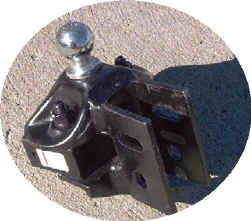
| WDH head with ball attached. |

| Shank which slides into your towing vehicles 2" square receiver on the receiver hitch. All the holes in the shank give you height adjustment and the L can go up or down to give you more hitch height adjustment |

| Spring bars or arms that are pinned to the WDH head and pinned to the V-tongue trailer hitch. These bars create the bridge between truck and trailer. |
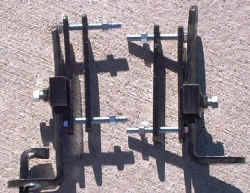
| Sway bracket, L bracket, L pin, clip and bolts that attach to the V-neck trailer hitch.. |

| Snap-up Lever included for attaching spring arms to trailer bracket. You can also use your trailer jack to help lift the spring arms into place. |
Putting it all together
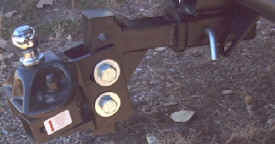
| Shank attached to the head and trailer ball with the L pointing down for adjusting hitch height downward. |
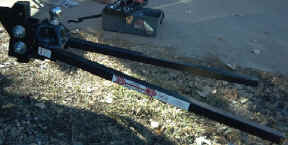
| Spring bars added to WDH head |
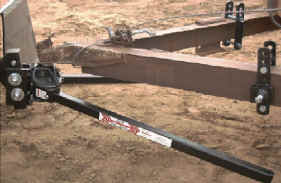
| Spring bars attached to head with quick pins, trailer coupler attached to ball attached to the head. |
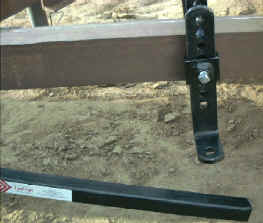
| L brackets and link plates attached to the V tongue hitch of the trailer |
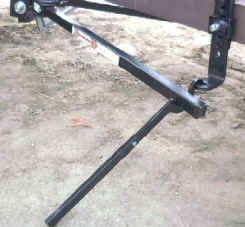
| The Snap-up lever in place to lift spring arms into L bracket |



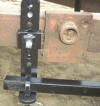
| Click on pictures to enlarge and back button to return. |
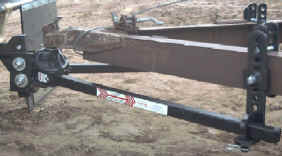
| Spring bars attached to head and trailer V-tongue, trailer coupler attached to the ball attached to the head. Notice the adjustments for moving the spring bars on the trailer. |

| This picture shows the spring bars moving on a corner with pressure for sway control provided by the bolts in the hitch head with the hinged trunnions. |
I know that most folks that don't use a Weight Distributing Hitch, and know about the benefits of them, is the hassle of hooking them up. Well I'm against hassles myself and that's why I can recommend Equal-i-zer hitches. It might, if you are as slow as me add 2 minutes to you hitching up time. And being able to adjust your towing rig to be level with even braking and bearing support along with losing the wag from your tail is sure worth 2 minutes.
E-Z On System
I'm including in this WDH article section, the best hitch guide I've seen. I saw this trailer guide at the National Western Stock Show last year. If you wanted an easier way to hookup your bumper trailer by yourself, this is the system. It's always been entertaining to watch a couple hooking up a trailer. Everyone uses different hand signals to tell the diver how close or which direction to turn when backing to a trailer. Sometimes the hand signals and voices become blurred as the sparks start flying!
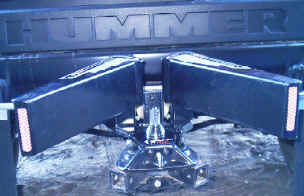
No need to add stress to trailering. So to start the trip off right, using the wings of the E-Z On System to guide the trailer hitch to the ball only using your mirrors all by yourself does work well. Besides being built to last, it will work with all trailer couplers even Bull Dog couplers as well as Weight Distributing Hitches. It has adjustments for all ball and shank sizes. Very few parts and the wings pull off to and fit under you seat. I've seen many types of ball guides, from ones I could have built in Jr. High to high tech folding, locking chrome arms. This trailer guide makes it simple. The only problem with it is it's only available one place. I wish that one place was me.

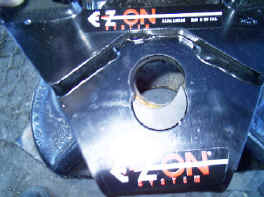
| The hitch alignment system comes with shims and spacers to fit all ball shanks. |


| I added the E-Z On hitch alignment system to my Equil-i-zer WDH |
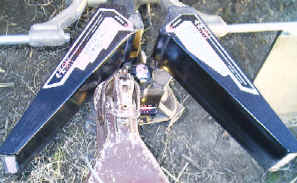 |
| Makes backing up to your trailer by yourself a one time event. |



Click to enlarge picture
Come visit me at
www.MrTruck.com A special thanks to Equal-i-zer Sway Control Hitch at 1-800-478-5578 and E-Z On System Hitch Guide at 1-888-847-3066
Till next time, Good Truck'n.
Kent Sundling (MrTruck)
http://www.mrtruck.net
See more articles from Mr. Truck

 This WDH is a dual cam type that allows the spring bars to double as anti-sway devices. The outside bar will increase pressure on the hitch movement as the inside bar rolls over the cam indent in the spring bar. This is Reese's Dual Cam Sway Control. Last year Reese introduced a Dual CamHP for heavy duty applications.
This WDH is a dual cam type that allows the spring bars to double as anti-sway devices. The outside bar will increase pressure on the hitch movement as the inside bar rolls over the cam indent in the spring bar. This is Reese's Dual Cam Sway Control. Last year Reese introduced a Dual CamHP for heavy duty applications. To explain what a WD hitch does, think of it as a bridge between the towing vehicle and your trailer. This bridge comes complete with an adjustable under truss called spring bar/arm or trunnion bars which join the trailer "V" tongue of the trailer to the hitch head and receiver hitch that arches the bridge upward to spread out the weight.. The head with the trailer ball attached to the trailer coupler/hitch, bolts to the shank which is "L" shaped with adjustment holes for proper hitch height. The shank slides in to your receiver hitch which is bolted to the towing vehicle's frame or sub-frame. This union allows you to distribute the trailer weight evenly to all axles of the truck/SUV and trailer. Thus the name "weight distributing" hitch. The picture here shows the shank, head, spring arms, chains and snap-up brackets with a typical WDH.
To explain what a WD hitch does, think of it as a bridge between the towing vehicle and your trailer. This bridge comes complete with an adjustable under truss called spring bar/arm or trunnion bars which join the trailer "V" tongue of the trailer to the hitch head and receiver hitch that arches the bridge upward to spread out the weight.. The head with the trailer ball attached to the trailer coupler/hitch, bolts to the shank which is "L" shaped with adjustment holes for proper hitch height. The shank slides in to your receiver hitch which is bolted to the towing vehicle's frame or sub-frame. This union allows you to distribute the trailer weight evenly to all axles of the truck/SUV and trailer. Thus the name "weight distributing" hitch. The picture here shows the shank, head, spring arms, chains and snap-up brackets with a typical WDH.


























 Click to enlarge picture
Click to enlarge picture